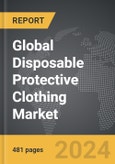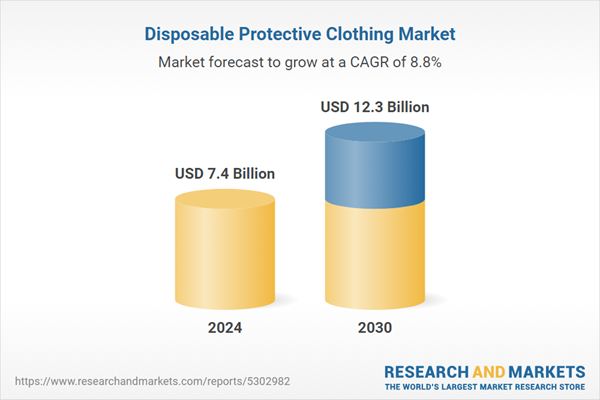The global market for Disposable Protective Clothing was valued at US$7.4 Billion in 2024 and is projected to reach US$12.3 Billion by 2030, growing at a CAGR of 8.8% from 2024 to 2030. This comprehensive report provides an in-depth analysis of market trends, drivers, and forecasts, helping you make informed business decisions. The report includes the most recent global tariff developments and how they impact the Disposable Protective Clothing market.
The use of disposable protective clothing is critical in environments where exposure to hazardous materials is frequent and the risk of cross-contamination is high. In healthcare settings, for instance, disposable gowns and gloves are vital for protecting healthcare workers and patients from infectious diseases. During the COVID-19 pandemic, the demand for such protective clothing surged dramatically as frontline workers required reliable and effective barriers against the virus. Similarly, in the industrial sector, workers handling chemicals or working in cleanrooms rely on disposable protective clothing to maintain strict hygiene standards and personal safety. These garments are also crucial in the food processing industry, where they help prevent contamination of food products.
The growth in the disposable protective clothing market is driven by several factors, including technological advancements, regulatory requirements, and heightened awareness of occupational safety. Innovations in material science have led to the development of more durable and comfortable protective clothing, enhancing user compliance and protection levels. Stringent regulations and standards set by bodies such as OSHA (Occupational Safety and Health Administration) and FDA (Food and Drug Administration) mandate the use of protective clothing in certain industries, further propelling market demand. Additionally, increased awareness of workplace safety and the potential health risks associated with hazardous exposures have led to a higher adoption rate of these garments. The pandemic has also permanently heightened the importance of personal protective equipment (PPE. Furthermore, the rise in industrial activities, especially in developing regions, coupled with the need for cost-effective and efficient protective solutions, supports market expansion.
Segments: Material Type (Polyethylene, Polypropylene, Polyester, Other Material Types); End-Use (Manufacturing, Oil & Gas, Construction, Healthcare, Other End-Uses).
Geographic Regions/Countries: World; USA; Canada; Japan; China; Europe; France; Germany; Italy; UK; Spain; Russia; Rest of Europe; Asia-Pacific; Australia; India; South Korea; Rest of Asia-Pacific; Latin America; Argentina; Brazil; Mexico; Rest of Latin America; Middle East; Iran; Israel; Saudi Arabia; UAE; Rest of Middle East; Africa.
The analysts continuously track trade developments worldwide, drawing insights from leading global economists and over 200 industry and policy institutions, including think tanks, trade organizations, and national economic advisory bodies. This intelligence is integrated into forecasting models to provide timely, data-driven analysis of emerging risks and opportunities.
Global Disposable Protective Clothing Market - Key Trends and Drivers Summarized
Disposable protective clothing refers to single-use garments designed to safeguard individuals from hazardous substances, including chemicals, biological agents, and particulate matter. These garments are essential in various industries such as healthcare, manufacturing, and chemical processing, providing a barrier against contamination and infection. Typically made from materials like polyethylene, polypropylene, and SMS (Spunbond-Meltblown-Spunbond) fabric, disposable protective clothing includes items such as coveralls, gowns, lab coats, and shoe covers. The design of these garments emphasizes both protection and comfort, ensuring that users are shielded from risks while maintaining mobility and breathability.The use of disposable protective clothing is critical in environments where exposure to hazardous materials is frequent and the risk of cross-contamination is high. In healthcare settings, for instance, disposable gowns and gloves are vital for protecting healthcare workers and patients from infectious diseases. During the COVID-19 pandemic, the demand for such protective clothing surged dramatically as frontline workers required reliable and effective barriers against the virus. Similarly, in the industrial sector, workers handling chemicals or working in cleanrooms rely on disposable protective clothing to maintain strict hygiene standards and personal safety. These garments are also crucial in the food processing industry, where they help prevent contamination of food products.
The growth in the disposable protective clothing market is driven by several factors, including technological advancements, regulatory requirements, and heightened awareness of occupational safety. Innovations in material science have led to the development of more durable and comfortable protective clothing, enhancing user compliance and protection levels. Stringent regulations and standards set by bodies such as OSHA (Occupational Safety and Health Administration) and FDA (Food and Drug Administration) mandate the use of protective clothing in certain industries, further propelling market demand. Additionally, increased awareness of workplace safety and the potential health risks associated with hazardous exposures have led to a higher adoption rate of these garments. The pandemic has also permanently heightened the importance of personal protective equipment (PPE. Furthermore, the rise in industrial activities, especially in developing regions, coupled with the need for cost-effective and efficient protective solutions, supports market expansion.
Report Scope
The report analyzes the Disposable Protective Clothing market, presented in terms of units. The analysis covers the key segments and geographic regions outlined below.Segments: Material Type (Polyethylene, Polypropylene, Polyester, Other Material Types); End-Use (Manufacturing, Oil & Gas, Construction, Healthcare, Other End-Uses).
Geographic Regions/Countries: World; USA; Canada; Japan; China; Europe; France; Germany; Italy; UK; Spain; Russia; Rest of Europe; Asia-Pacific; Australia; India; South Korea; Rest of Asia-Pacific; Latin America; Argentina; Brazil; Mexico; Rest of Latin America; Middle East; Iran; Israel; Saudi Arabia; UAE; Rest of Middle East; Africa.
Key Insights:
- Market Growth: Understand the significant growth trajectory of the Polyethylene segment, which is expected to reach US$5.2 Billion by 2030 with a CAGR of a 9.4%. The Polypropylene segment is also set to grow at 9.0% CAGR over the analysis period.
- Regional Analysis: Gain insights into the U.S. market, valued at $2.3 Billion in 2024, and China, forecasted to grow at an impressive 11.1% CAGR to reach $2.0 Billion by 2030. Discover growth trends in other key regions, including Japan, Canada, Germany, and the Asia-Pacific.
Why You Should Buy This Report:
- Detailed Market Analysis: Access a thorough analysis of the Global Disposable Protective Clothing Market, covering all major geographic regions and market segments.
- Competitive Insights: Get an overview of the competitive landscape, including the market presence of major players across different geographies.
- Future Trends and Drivers: Understand the key trends and drivers shaping the future of the Global Disposable Protective Clothing Market.
- Actionable Insights: Benefit from actionable insights that can help you identify new revenue opportunities and make strategic business decisions.
Key Questions Answered:
- How is the Global Disposable Protective Clothing Market expected to evolve by 2030?
- What are the main drivers and restraints affecting the market?
- Which market segments will grow the most over the forecast period?
- How will market shares for different regions and segments change by 2030?
- Who are the leading players in the market, and what are their prospects?
Report Features:
- Comprehensive Market Data: Independent analysis of annual sales and market forecasts in US$ Million from 2024 to 2030.
- In-Depth Regional Analysis: Detailed insights into key markets, including the U.S., China, Japan, Canada, Europe, Asia-Pacific, Latin America, Middle East, and Africa.
- Company Profiles: Coverage of players such as Cardinal Health, Inc., Delta Plus Group, Asatex AG, Bennett Safetywear Ltd. (BSL), CWS-boco International GmbH and more.
- Complimentary Updates: Receive free report updates for one year to keep you informed of the latest market developments.
Some of the 101 companies featured in this Disposable Protective Clothing market report include:
- Cardinal Health, Inc.
- Delta Plus Group
- Asatex AG
- Bennett Safetywear Ltd. (BSL)
- CWS-boco International GmbH
- Charnaud & Co., (Pty) Ltd.
- APEX Medical Corporation
- BBWear Ltd.
- Biolene Srl
- Cellucap Manufacturing
- dastex Reinraumzubehor GmbH & Co. KG
- CEABIS
- Changzhou Ankang Medical Instruments Co., Ltd.
- DACH Schutzbekleidung GmbH & Co. KG
- Cordova Safety Products
Tariff Impact Analysis: Key Insights for 2025
Global tariff negotiations across 180+ countries are reshaping supply chains, costs, and competitiveness. This report reflects the latest developments as of April 2025 and incorporates forward-looking insights into the market outlook.The analysts continuously track trade developments worldwide, drawing insights from leading global economists and over 200 industry and policy institutions, including think tanks, trade organizations, and national economic advisory bodies. This intelligence is integrated into forecasting models to provide timely, data-driven analysis of emerging risks and opportunities.
What’s Included in This Edition:
- Tariff-adjusted market forecasts by region and segment
- Analysis of cost and supply chain implications by sourcing and trade exposure
- Strategic insights into geographic shifts
Buyers receive a free July 2025 update with:
- Finalized tariff impacts and new trade agreement effects
- Updated projections reflecting global sourcing and cost shifts
- Expanded country-specific coverage across the industry
Table of Contents
I. METHODOLOGYII. EXECUTIVE SUMMARY2. FOCUS ON SELECT PLAYERSIII. MARKET ANALYSISCANADAITALYSPAINRUSSIAREST OF EUROPESOUTH KOREAREST OF ASIA-PACIFICARGENTINABRAZILMEXICOREST OF LATIN AMERICAIRANISRAELSAUDI ARABIAUNITED ARAB EMIRATESREST OF MIDDLE EASTIV. COMPETITION
1. MARKET OVERVIEW
3. MARKET TRENDS & DRIVERS
4. GLOBAL MARKET PERSPECTIVE
UNITED STATES
JAPAN
CHINA
EUROPE
FRANCE
GERMANY
UNITED KINGDOM
ASIA-PACIFIC
AUSTRALIA
INDIA
LATIN AMERICA
MIDDLE EAST
AFRICA
Companies Mentioned (Partial List)
A selection of companies mentioned in this report includes, but is not limited to:
- Cardinal Health, Inc.
- Delta Plus Group
- Asatex AG
- Bennett Safetywear Ltd. (BSL)
- CWS-boco International GmbH
- Charnaud & Co., (Pty) Ltd.
- APEX Medical Corporation
- BBWear Ltd.
- Biolene Srl
- Cellucap Manufacturing
- dastex Reinraumzubehor GmbH & Co. KG
- CEABIS
- Changzhou Ankang Medical Instruments Co., Ltd.
- DACH Schutzbekleidung GmbH & Co. KG
- Cordova Safety Products
Table Information
| Report Attribute | Details |
|---|---|
| No. of Pages | 481 |
| Published | April 2025 |
| Forecast Period | 2024 - 2030 |
| Estimated Market Value ( USD | $ 7.4 Billion |
| Forecasted Market Value ( USD | $ 12.3 Billion |
| Compound Annual Growth Rate | 8.8% |
| Regions Covered | Global |









